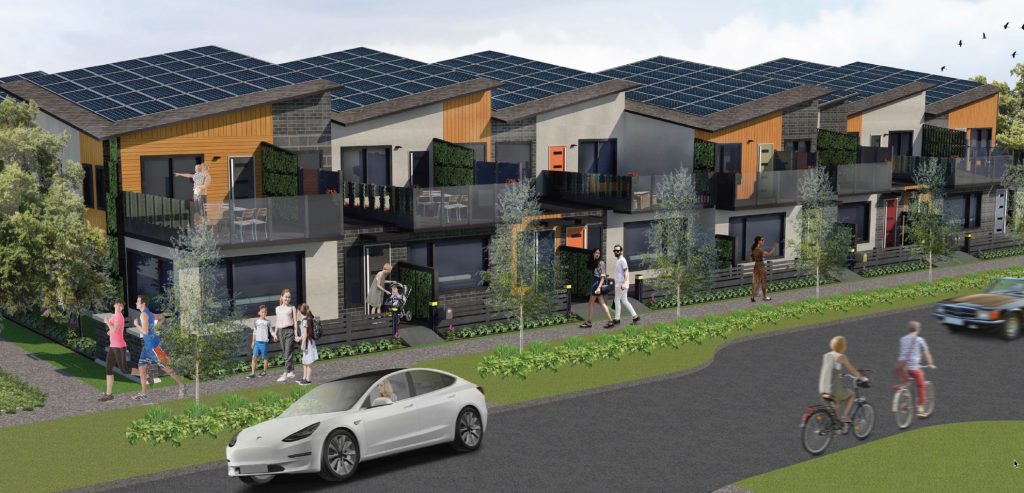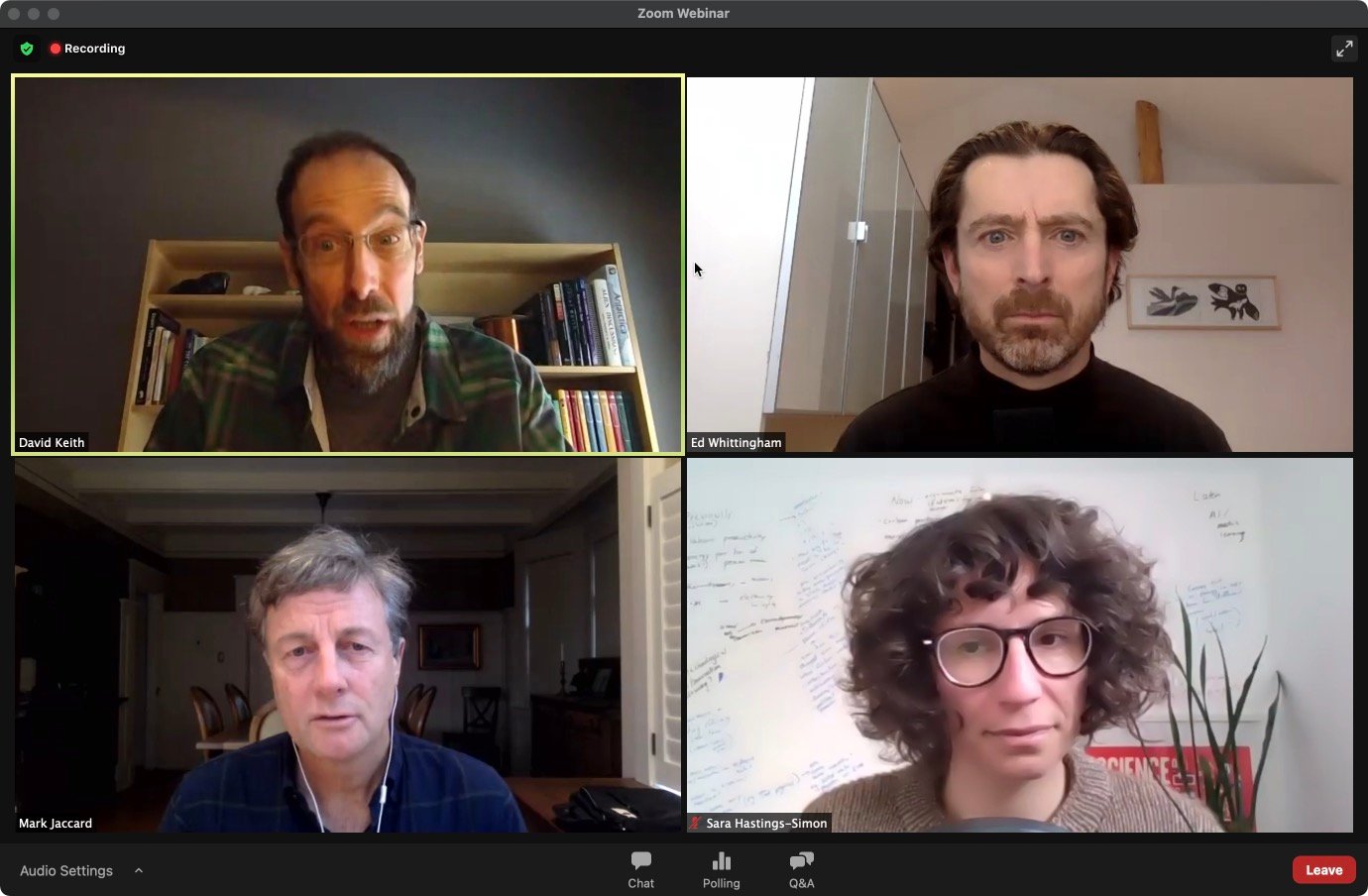By David Dodge
Canada just updated its climate plan which seeks to reduce greenhouse gas emissions by 30 per cent by 2030 and get Canada to “net-zero emissions” by 2050.
Is it up to the task of fighting climate change and meeting Canada’s Paris Accord goals? The panel of energy experts at the Energy vs Climate podcast tackled this question in a one-hour webinar that features host Ed Whittingham, physicist Dr. Sara Hastings-Simon, Harvard professor Dr. David Keith, and special guest Dr. Mark Jaccard author of The Citizen’s Guide to Climate Success.
The update to the climate plan released in December promises billions in support of clean energy, green infrastructure, energy efficiency programs for consumers, and supports for electrification of transportation for individuals and municipalities.
But what’s really been grabbing people’s attention is Canada’s commitment to increase the price of carbon emissions by $15 per tonne per year, starting in 2023. Beginning with a price of $50 per tonne in 2022, that means Canada is set to hit $170 per tonne by 2030.

Canada’s climate plan could meet the Paris targets—in theory
“If you’d asked me whether I thought we would have a climate policy this strong, I would have bet against it,” says Dr. David Keith. Uncharacteristically, Keith gushed a little: “I am really thrilled and proud that this happened. It’s a big deal by any measure. And I think it says something important about the way the world may be shifting towards more aggressive climate policies.”
The first big question is: Will Canada’s updated climate plan cut emissions by 30 per cent by 2030 and get us to a net-zero economy by 2050?
Jaccard says Navius, an environmental research firm, has done some preliminary modelling; under most of their scenarios, he says, “it would get us close to the Paris target.”
Nadius’s model makes a few assumptions about Canada’s path forward, including that it will transition to renewable energy, decarbonize industry, electrify transportation, and invest in hydrogen. The model also depends heavily on carbon capture and storage.


Putting a price on pollution is key
Perhaps the most important component of the federal climate plan is putting a price on pollution. Despite Keith’s enthusiasm for the $170 carbon price, he acknowledge that there will be challnged. “There’s lots of complexity under the hood. And I personally think the chance of actually getting emissions cuts that big by 2030 is pretty low.”
Keith says the rollout of technologies such as those used in carbon capture and storage (CCS) will take longer in the real world and it will be hard to “get 40 or so megatons a year of CCS by 2025.”
Canada has other tools to draw on—the clean fuel standard, for example. Jaccard says that this is a key element of the climate plan, as it can be “a way of incentivizing, like a carbon price, to reduce emissions in transportation.”
“If I’m selling gasoline, and I don’t have…a way of lowering carbon intensity. I have to subsidize somebody who’s selling electricity from clean sources or hydrogen from clean sources,” explains Jaccard. It appears the clean fuel standard will be modelled after California’s low carbon fuel standard.
Still, Keith is wary. With such a complex approach, he worries are the potential for “gaming” the system.
Canada’s new climate plan: A 10-minute primer

The climate plan update builds on the 2016 Pan-Canadian Framework on clean growth and climate change.
Canada’s goal is to reduce overall emissions by 30 per cent by 2030. According to the new climate plan, this will involve reducing emissions by specific minimum percentages in the following areas:
- Oil and gas: 34%
- Electricity: 15%
- Heavy industry: 15%
- Buildings: 14%
- Waste and other: 9%
- Land-based: 9%
- Transportation: 4%
- 7) Agriculture: 1%
As already discussed, Canada proposes to reach these targets by putting a price on pollution (reaching $170 per tonne of carbon emissions by 2030) and by implementing a clean fuel standard.
The plan also includes continued support for clean transportation in the form of incentives for electric vehicles, a network of fast chargers, and zero emissions transit.
Clean electricity is a cornerstone of the new plan. Before the most recent update, Canada’s climate plan had already committed $1.72 billion to help clean up orphan wells in Alberta, British Columbia, and Saskatchewan; introduced new regulations to reduce methane emissions; and promised $750 million to reduce greenhouse gas emissions in the oil industry.
Now, the plan will also invest in a $3 billion net-zero accelerator program to “expedite decarbonization projects with large emitters.”
Eighty per cent of Canada’s electricity is already net-zero emissions, with the majority of this so-called clean energy coming from hyrdoelectricity on the national scale. The goal is to reach 90 per cent by 2030.
If you come from a province like Alberta, you might be surprised to hear a figure like “80 per cent zero emissions.” That’s because Canada’s biggest emitters are provinces, like Alberta and Saskatchewan, that are still reliant on coal and gas-fired generation.
However, industry is starting to embrace the concept of net-zero emissions with numerous companies on board already. As a province, Alberta plans on completing its phase out of coal-generation in 2023, seven years ahead of the 2030 deadline. Alberta’s Capital Power has committed to net-zero emissions by 2050. The company is repowering its Genesee coal plant to combined-cycled natural gas with the ability to transition to hydrogen in the future. The company is also building renewable energy projects and purchasing renewable energy from other developers.
Canadian oil companies Cenovus and Husky have also established net-zero goals for 2050 for upstream emissions along with numerous international players such as BP, Shell, Total, Repsol and Equinor.
The federal climate plan needs to get 29 per cent of its emissions reductions from oil and gas to be successful.
Beyond clean energy, the federal plan will also invest in clean energy infrastructure.

When it comes to homes and buildings, the federal plan is developing a net-zero-ready model building code, including new standards for furnaces and water heaters. It will also invest more than $4 billion through various programs to retrofit homes, businesses, and municipal buildings. This will include $2.6 billion, or 700,000 individual grants of a maximum of $5,000, for energy efficiency retrofits in homes.
The federal plan also targets nature based solutions, waste reduction, and agriculture for further emissions reduction.
Polls say Canadians support climate action, but carbon pricing is a volatile issue
As a whole, the panel shared Keith’s enthusiasm for the climate plan, but the rubber really hits the road when you start talking about carbon pricing.
“Carbon pricing is a volatile issue,” says Jaccard. He says GDP growth will slow from 2.1 per cent growth to 1.9 per cent, taking a 0.2 per cent hit.
People always focus on the change to GDP, but not the benefits of having tackled and solved the biggest social, environmental and economic challenge in human history.
“I think it’s really important that we be talking about it from a wellbeing perspective because…that’s frankly what matters at the end of the day,” says Hastings-Simon.
While the carbon price will rise to $170 per tonne by 2030, the cost to industry will be lower.
“A federal Output-Based Pricing System will mean the average cost of carbon is much lower to industry to ensure ‘reasonable competitiveness’,” says Jaccard.
“Carbon tariffs” or “border carbon adjustments” will be needed to ensure that industry is not disadvantaged by different levels of carbon pricing, says Jaccard—but he thinks it’s unlikely that these will be implemented in the near future.
Perhaps the biggest wildcard on climate policy is politics itself.
62% of Canadians personally believe global warming is a “major crisis.”
Reserachco.ca
Still, Canadians know that it’s time to get serious about climate change. Research Co. poll found that 69 per cent of Canadians say governments should be doing more, 75 per cent say companies should do more, and 64 per cent say individuals should do more to fight climate change.
“Canadians want to see action on climate. I think what we don’t know completely is how good the electorate is at judging plans that are put forward by politicians that claim to be action on climate,” says Hastings-Simon.
In truth, a serious plan to address climate change must address carbon emissions reductions in all sectors. Even then, there is going to be a black hole that must be filled through carbon capture and storage.
The current federal plan is comprehensive but complicated. This is the source of David Keith’s skepticism: will we be able to deliver on such a complicated plan?
Moreover, even if the plan is perfectly executed, it will only get us to the Paris goals by the skin of its teeth.
However, skepticism, complications, and challenges don’t equal impossibility. One thing this panel of experts does seem to agree on is that the Canadian plan is viable, at least in theory—and that’s saying something.
Green Energy Futures partnered with Energy vs Climate on this episode. Visit energyvsclimate.com to sign up for their next live webinar episode and to listen to their panel of experts in hour-long discussions on energy and climate change topics.

